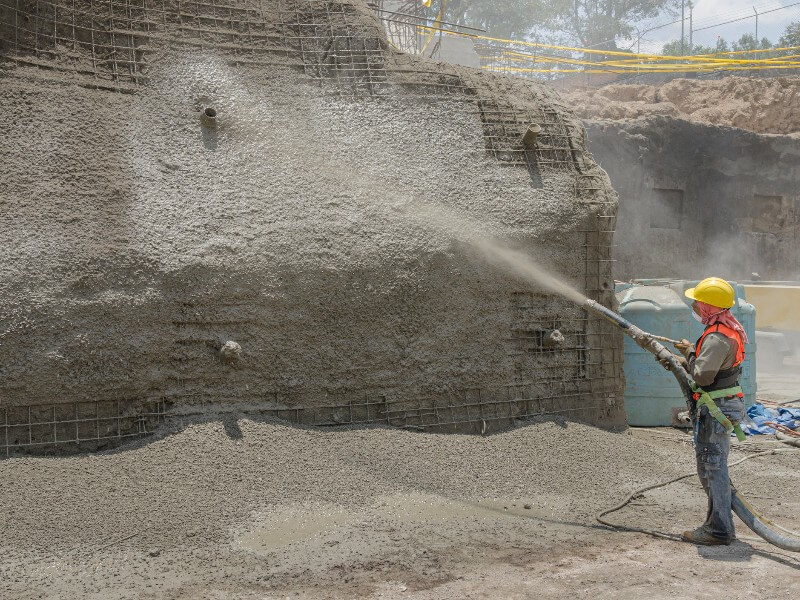
Concrete is one of the most widely used materials in construction, serving as the foundation for many buildings, homes, and other structures. It's also quite versatile, with variations in formula and application to meet different needs. A good example of this is shotcrete.
Depending on the type of project, this option may be the best option for fast and efficient work. To use shotcrete correctly, it's important to understand its advantages and disadvantages, and how they all affect your project planning.
Follow and understand more about shotcrete and in which contexts it can be used.
Shotcrete isn't a type of concrete per se, but rather an application method. It involves using high pressure to project the product directly onto a surface—hence its name.
This method is quite common in places that use underground structures. steel and concrete, since its application is quick, simple, and practical. For example, shotcrete is widely used in lining projects for tunnels, bridges, dams, and walls, where the work time must be as short as possible.
Similarly, you can apply this method to the construction of buildings, swimming pools, or building facades. It's just a matter of understanding the advantages of this technique and how to take advantage of them.
Using shotcrete brings a number of benefits to your projects. See some examples below!
One of the main differences between shotcrete and traditional concrete is the speed of the process. With this method, you begin by preparing the steel reinforcement. Then, you apply the concrete to the structure using pressure, which takes much less time.
For this reason, this method is most recommended for projects seeking maximum agility, especially in enclosed spaces or high-traffic areas. This allows the project to be completed in less time, freeing up space for circulation.
Another aspect that contributes to the agility of this method is proper compaction of the concrete. Because the material is projected under high pressure against the surface, compaction occurs quickly, expelling air from the mix and favoring its solidification.
Typically, it takes some time to compact the concrete, either through vibration or external pressure. However, with this method, much of the work is done during application, which is crucial for increasing the compaction rate. productivity in construction.
During concrete application, it's important to keep the concrete moist to ensure adhesion, a process called curing. When applied correctly, shotcrete is more resistant to water loss, facilitating curing.
This means your team will have an easier time applying top coats of concrete throughout the construction process, an important point for large-scale projects where complete concrete adhesion occurs gradually. This means you can apply multiple coats without risking cracks or structural failures.
Just like any tool in the civil construction, shotcrete isn't the right choice for every type of project. Here are some cases where this method may not be ideal.
The application of shotcrete generates a large volume of loose particles that end up in the air. When this occurs, an area may become unsuitable for circulation until the material disperses. Furthermore, if there is little or no air circulation in the space, the dispersion time is longer.
During construction, these particles can pose a risk to the health and well-being of your team, requiring dedicated PPE and new safety procedures. Similarly, it may take longer for the site to be ready for use again.
Another point that requires attention is the amount of material that is wasted during application. Depending on how the process is performed, much of the concrete ends up not being used in the project, which also impacts costs.
An experienced professional can reduce this waste, but it will still cost more than using traditional concrete. It's important to consider this additional cost and determine whether it offsets the reduction in overall construction time.
There are two methods used to apply shotcrete: dry and wet. Let's take a look at their main features.
In this method, the cement and other aggregate mixture is pressure-fed to the application nozzle. The nozzle also has a water inlet system, ensuring that the concrete only comes into contact with water during application.
The main advantage of this method is that the material becomes much more compact relative to the surface, since there is no initial moisture. However, moisture is still necessary to ensure proper adhesion. Therefore, the quality of this method depends primarily on the professional, who controls the volume of water used.
Alternatively, you can use the wet method, in which water is mixed before spraying. This way, the amount of moisture is pre-defined, without the need for professional intervention.
The wet process is practical and helps preserve projection equipment by reducing the amount of dust and solid debris. This is important when you're working on long projects.
Now you better understand what shotcrete is, its qualities, and the contexts in which the method can be used. If you're looking for a faster option for your projects and considering investing in the necessary equipment, this is a great way to expand your construction options.
Was this article helpful? Share it on social media and show more people the benefits of shotcrete.